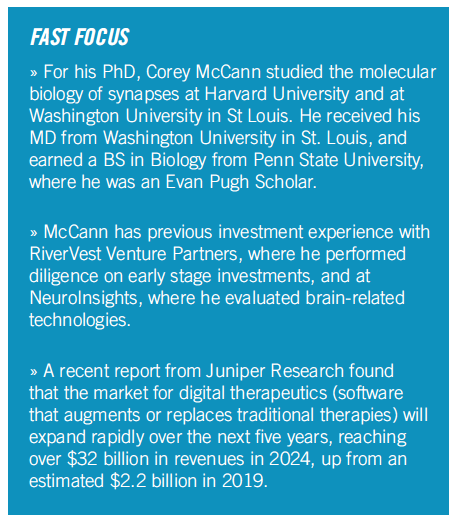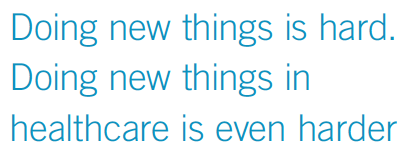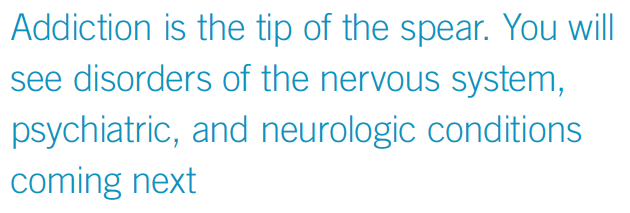Corey McCann: A PDT Pioneer
Pharmaceutical Executive
Corey McCann, president and CEO of Pear Therapeutics, discusses how the prescription digital therapeutics space has evolved in a decade from disruptive concept to an exciting, growing market.
Pharm Exec speaks with Corey McCann, president and CEO of Pear Therapeutics, a major player in the emerging field of prescription digital therapeutics (PDTs), who discusses how software-based treatments are performing in the real world and what’s next for these therapies in impacting new disease areas
Pear Therapeutics, based in Boston, MA, and San Francisco, CA, is a leader in prescription digital therapeutics (PDTs), which are medical apps that have demonstrated safety and efficacy in randomized clinical trials, received marketing authorization from FDA for their labeled indications, are prescribed by a doctor, and are designed to be reimbursed like other
Corey McCann at Pear Therapeutics' Boston office.

prescription products. In September 2017, Pear’s lead product, reSET, for substance use disorder, was the first PDT granted authorization by FDA to treat disease. The company’s second product, reSET-O, for the treatment of opioid use disorder, received marketing authorization from FDA in December 2018. That year, Pear also raised $50 million in Series B funding and signed a deal with Novartis to market its line of PDTs. In January, Pear announced it closed a $64 million Series C funding led by Temasek.
Corey M. McCann, MD, PhD, the company’s president and CEO, trained as a physician-scientist via the Medical Scientist Training Program and completed post-doctoral research at the Massachusetts General Hospital. During his tenure as an engagement manager at McKinsey & Co. from 2009–2011, he led McKinsey’s central nervous system expertise group. Moving to MPM Capital as an investor, McCann later branched out and co-founded Pear in 2013.
Pharm Exec sat down with McCann to chronicle his journey as a prescription digital therapeutics pioneer, discuss how PDTs are performing in the real world, and see how they are positioned to reach out into new treatment areas.
PE: Can you outline how your early career led you to co-found Pear Therapeutics?
McCANN: Training as a physician-neuroscientist, I spent a lot of time looking at the interaction between molecules and experience in patterning the nervous system, and in the way that the brain learns and recovers after injury. Ten years later, as a life sciences venture capitalist at one of the larger investment firms, MPM Capital, I continued to have this very pronounced interest and concern around diseases of the nervous system. However, at that time I was encountering oncology and rare disease investments, one after another and I was a little bit frustrated that I wasn’t able to advance new treatments for patients with brain-related conditions.
So, I started racking my brain about novel ways to be able to treat these conditions. Thinking back to my scientific training, the answer was fairly obvious-it was to push that lever of cognitive experience.
That was the seed for what at that time was this crazy concept of software as a drug, which has since become digital therapeutics. The whole story is about trying to take a pharma-grade approach to the development of these different things that stimulate cognitive experience and ultimately treat disease.
PE: What kind of resistance did you encounter in the early days?
McCANN: When I made a move into this space, I wouldn’t even say it was a space. The context in which I thought it was interesting was in pulling together a fund. The first thing that you do when you pull together a fund is you “boil the ocean.” You look at the entirety of what you could possibly invest in. I looked at probably a thousand different technologies and I became increasingly compelled that there was some really interesting biology there. But the whole space was not yet ready for prime time in terms of the management teams, regulatory strategy, clinical strategy, and most importantly the commercial model.

Doing new things is hard. Doing new things in healthcare is even harder. When we were first telling the story, most people didn’t even understand what we were proposing. For those that heard us out, it looked like this whole new space was designed to make just about everyone uncomfortable.
Traditional biotech investors have a hard time wrapping their heads around software and around the evolutionary nature of software.
PE: How did you choose which products to develop?
McCANN: I’m a recovering McKinsey consultant and, I guess in that spirit, everything for me lives in a two-by-two matrix. We believed from day one that this was a whole new therapeutic modality, and that the options here were almost limitless. If you believe that the opportunity is that large, you want to be able to construct the best portfolio you can possibly construct. Every McKinsey consultant who’s ever gone into a pharma company displays the same two-by-two matrix: Will this thing work, i.e., probability of success, and size of unmet medical need, i.e., market size. If you think about the world through that lens, addiction and substance use disorders gravitate “up and to the right” in that metaphorical two-by-two matrix.
We’ve known for quite some time that different forms of talk therapy are able to activate neural circuitry and directly address addiction conditions. If you look at the pharmaceutical pipeline for addiction, it’s been quite some time since that space has seen any innovation at all. That’s why we started in addiction conditions.
PE: In 2017, Pear’s reSET became the first prescription digital therapeutic to receive authorization from FDA. What did that mean for you as a company?
McCANN: The 2017 regulatory event was just a huge inflection point for Pear Therapeutics, and also for this whole space. Just to reemphasize the importance, Pear’s reSET was the first piece of software to ever receive disease treatment claims for any disease. This was not just about addiction, it was about this whole new modality of PDTs.
There were a lot of folks in industry and in the investment community who weren’t familiar with Pear at that time. In healthcare and in pharma, the devil is always in the data. This was the moment where we were able to signal what I would call legitimacy for this whole therapeutic class. It proved out the first part of the thesis, which is that software could create therapeutic-like efficacy, and because of that, software could receive a therapeutic-like label.
PE: Can you explain a little about how reSET and reSET-O work?
McCANN: reSET is a monotherapy. There is no drug Âcomponent, and it’s indicated for patients with substance use disorder, who do not abuse alcohol solely and who do not abuse opioids as their primary substance of abuse. reSET-O is a combination therapy. It’s indicated for use in combination with buprenorphine, specifically to treat opioid use disorder. Both are indicated for patients 18 years of age and older who are currently enrolled in outpatient treatment under the supervision of a clinician.
The way that these products work is that the patient presents to their physician and they receive their diagnosis. The physician then writes the prescription, and that brings into the loop our reSET Connect facility, which is the first patient

service center and specialty pharmacy for a PDT. Physicians send a form to reSET Connect and reSET Connect dispenses the prescription, which in this particular case is an access code.
The patient uses their own device, downloads the product, and the code unlocks the product for a period of time that corresponds with the prescription. In the case of reSET and reSET-O, these are 12-week prescriptions. Both of these treatments are what we call module-based. There are modules whose content deliver a specific type of cognitive behavioral therapy for addiction, for example. Patients complete four of these modules per week. That’s actually the “dose,” and they work their way across that 12-week treatment paradigm. The physician can then refill the prescription at the end of the 12 weeks, just like you would refill a bottle of pills.
PE: How have patients and physicians adapted to these new treatments?
McCANN: I think the world’s understanding of the modality has evolved quickly, and we find ourselves now being contacted by investors, by pharma companies, by payers, and by providers who have a “digital therapeutic strategy.” They have heard of digital therapeutics and they’ve heard of PDTs before they’ve heard of Pear, which is a great thing.
We’ve gone effectively from zero understanding in 2015, 2016, to the point where this is a hot new modality in 2019.
That’s very gratifying for us, and what we find, in particular with patients and clinicians, is that the conversation very quickly goes from “What is this?” to “How do I use this?” If you look in particular at our reSET product, this is the only product with a labeled claim encompassing addiction to cannabis, cocaine, and stimulants. There are other products off label, but for those three conditions, this is the only product with supporting clinical data. It’s helpful to be able to articulate that to clinicians, so that they can understand that this is standard of care. This is a conversation about data and outcomes first and the fact that it is a piece of software second.
PE: Is it difficult with these treatments to get patients to adhere, to “take their daily dose,” if you will?
McCANN: The most important thing to point out is that unlike a traditional pharmaceutical product, we know everything about adherence. While individual patient data are strictly confidential and our data security practices meet medical standards, we know when patients interact with the product, we know what parts of the product patients interact with.
The term prescription digital therapeutics is actually a bit of an undersell in that we also push digital diagnostics and assessments along with the product. We’re able to collect patient-reported outcomes throughout the treatment course. What we see is actually in the real world, patients are engaging with these products either as frequently or more frequently than we saw in clinical trials.
That hits upon the evolutionary nature of software. We’ve learned so much from the patients that we are well positioned to enhance our products over time as well as improve our product development process overall as we integrate patient feedback.
We see this beautiful dose–response curve that’s associated with patients using the reSET product; the more modules a patient completes, the more likely that they are to display abstinent behavior. Unlike many drugs, you don’t see a tailing-off of the dose–response curve because of the side-effect profile. This speaks nicely to the therapeutic-like nature of the development of these PDTs.
PE: What’s next for Pear Therapeutics and for the broader digital therapeutics space?
McCANN: The immediate next step is about making reSET and reSET-O standard of care in different addiction conditions. I think we’re at the beginning of that conversation, but we have much more work to do.
Addiction is the tip of the spear. You will see disorders of the nervous system, psychiatric and neurologic conditions coming next. That’s what’s in our pipeline. I believe that in the next five years or so that PDTs will be standard of care across CNS conditions.

Looking at the five-to-10-year window, I think PDTs will also be standard of care outside of CNS conditions. This is not just a story about the brain, it’s a story across therapeutic areas. In that time window, you’ll also see all drugs being launched with some sort of a software wraparound to the point where this is what patients, clinicians, and payers expect.
You’ll see advancements into cardiovascular, metabolic conditions, musculoskeletal conditions. You’ll also see PDTs move into areas like anti-infectives and oncology.
This is about the fundamental tethering of drugs and software and the collection of real-world data to inform drug dosing in real time-helping patients to understand how much medication to take, when to take the medication, and creating these closed-loop dosing paradigms.
Julian Upton is Pharm Exec’s European and Online Editor. He can be reached at jupton@mmhgroup.com
